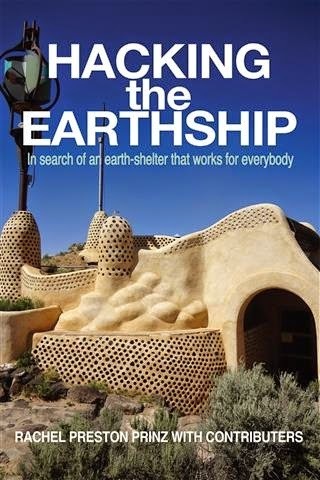Table of Contents
For those who wonder what all we cover...
pdf
Introduction Background and Methodology Our Earthship Survey
The Earthship Reality Project The Mythos The Myth of “The Most Economical Building Design in the World... (which will) cost about the same as a conventional non-sustainable home…” The Myth of “A Radically Sustainable Home Made of Recycled and Natural Materials…” The Myth of Earthships and Recycling The Myth of “The Most Efficient, Easy to Build Construction Method on the Planet” The Myth of Build-Out Time
The Myth of “Will Perform as Expected in Any Part of the World, in Any Climate” or, Reality Check: There is no such thing as a Global Model The Myth of “Will Provide You with What You Need to Survive…” The Myth of Thermal Comfort The Myth of Performance: Known Issues in Earthships Worldwide The Myth of Custom Design The Myth of Education The Myth of Getting it Built by People who are Willing to Pay The Myth of “A Higher Resale Value.” The Myth of Awesome Community
“Just the Facts, Ma’am” Issues with the Data The Tire Issue The Earthship at the End of its Life Earthship Life Cycle Cost Assessment Earthships are not for Everybody Motivation: Why we have to do something MORE The Science: Academic Research and Tire Off-gassing Academic Research on Earthship Performance Analysis of the Performance of Earthship Housing in Various Global Climates Thermal Comfort of Global Model Earthship in Various European Climates Learning from ‘Earthship’ Based on Monitoring and Thermal Simulation The Sustainability of Conventional Houses, Passive Houses and Earthships, Based on Legislation, Environmental Impact Energy and Operating Energy Earthship Performance Case Study Report: The Brighton Earthship: Evaluating Thermal Performance Earthship Ironbank Testing and Analysis of Modified Rammed Earth Tire Walls Earthship Biotectures: Experimental Subdivision in Taos, New Mexico: The Greater World Earthship Community Research Conclusions Tires and Off-gassing Research
A Way Forward Earthship .: Reinventing Home Design with YOU in Mind Sustainable Home Working towards a Better Definition of Sustainability Cost Effective Sustainable Features Minimizing Waste and Pollution From Vision to Reality Where You Live Now Wish List Setting a Vision Idea Book Site Diagram Where is the Money? How to Afford to Pay Cash for Your Home Mortgage Financing Tools to Facilitate Financing Creative Funding Solutions Pick the Right Materials Homeowners Bill of Rights Tax Incentives for Green Design Budgeting for a Contractor Deciding Factors Insurance for the Non-Traditional Home Planning a Build Getting it Built: Managing Volunteers Regulatory Forces –The Code
Design The Building’s Context and Site Land Uses The Best Design of All: At the Intersection of Two Ecosystems Choosing a Building Site Geography Topography and Climate Working with Microclimates General Site Design Criteria Landscaping Growing your Own: Dan’s EPIC Garden Outdoor Living Fire-Wise Design Vernacular Design Principals North Pacific Vernacular Zone Rocky Mountain Vernacular Zone Southwest Vernacular Zone Great Plains / Prairie Vernacular Zone Lakes Vernacular Zone Northeast Vernacular Zone Southeast Mountain Vernacular Zone Southeast Coastal Vernacular Zone Designing for Thermal Comfort Passive Solar Design Ultra-Tight Construction Other Ways of Staying Cool Other Ways of Staying Warm Thermal Mass versus Insulation Thermal Mass for Heating Thermal Mass for Cooling Earth-Coupling and Earth-Sheltering Natural Ventilation Strategies and Indoor Air Quality Using Windows for Ventilation Other Means of Ventilation Earthship Ventilation Issues Earthship Cooling Tubes and Alternatives Indoor Air Quality Humidification Matters Thermal and Moisture Protection Roof Thermal Performance Improvements Framing for Thermal Performance Thermal Bridging Choosing Insulation Earthship-Specific Thermal and Moisture Protection Issues Acoustics - Sound Insulation The Structural System Foundations Rubble Trench Foundations Floor Structures Framing The Enclosure System Secrets of Great Curb Appeal Walls Natural versus Sustainable Materials Insulating Versus Thermal Mass Building Materials Strawbale vs. Cob Traditional Earthship Building Blocks Tire Walls Earthship Greenhouse Glass Block and Bottle Walls Can Walls Other Types of Walls Soil Factors for Rammed Earth, Adobe, Cob, and Earthbag Construction Expansion and Control Joints Adobe Cob Rammed Earth Earthbags Wood Block Concrete Forms Wood and Log Construction Timber frame Log Buildings Cordwood Strawbale Stone Concrete Roofing Earthship Roofing Considerations Roof Structure Roofing Types Doors and Windows Doors Windows
Rooms, Spaces, Colors, & Textures Create an Efficient Floorplan Starting Small Easy Spaces What about All My Stuff? Living Simply with Less Other Interior Considerations Entrance Courtyards Hallways & Hidden Hallways Living Room Dining Rooms Great Room Kitchens and Baths Kitchens Bathrooms Bedrooms Second Floors and Lofts Storage Laundry Room Garage Root Cellar Stairs and Towers Standard Furniture Dimensions Details of Design Planning for the Long Game Universal Design Finishes Glues Paints and stains Wall Coverings Floor Coverings
Mechanical Systems Mechanical Heating and Cooling Mechanical Rooms Mechanical Heating Fireplaces and Stoves Mechanical Cooling & Air Conditioning Typical Earthship Mechanical Systems Electrical Systems Lighting Power The Art and Science of Outlets and Switching Appliances Plumbing Water Flow Water Heaters Waste Management Rainwater Harvesting and Collection Greywater Maximizing Efficiency in Water Use Final Notes on Mechanical Systems Imbuing Space with Spirit What is Happy, Anyway? Your Core Desired Feelings Locating “Power Spots" Creating Sacred Spaces Correct timing Vaastu & Feng Shui Vaastu Feng Shui
Conclusion: A New Set of Earth-shelter Building Criteria
Overwhelmed? Need Help? Hiring an Architect or Designer Stages of Design
APPENDICES New Home Design Worksheet Site Design Checklist Participate! Suggested Reading Earthships around the World
Index About the Author Contributors
Buy the book now
Introduction Background and Methodology Our Earthship Survey
The Earthship Reality Project The Mythos The Myth of “The Most Economical Building Design in the World... (which will) cost about the same as a conventional non-sustainable home…” The Myth of “A Radically Sustainable Home Made of Recycled and Natural Materials…” The Myth of Earthships and Recycling The Myth of “The Most Efficient, Easy to Build Construction Method on the Planet” The Myth of Build-Out Time
The Myth of “Will Perform as Expected in Any Part of the World, in Any Climate” or, Reality Check: There is no such thing as a Global Model The Myth of “Will Provide You with What You Need to Survive…” The Myth of Thermal Comfort The Myth of Performance: Known Issues in Earthships Worldwide The Myth of Custom Design The Myth of Education The Myth of Getting it Built by People who are Willing to Pay The Myth of “A Higher Resale Value.” The Myth of Awesome Community
“Just the Facts, Ma’am” Issues with the Data The Tire Issue The Earthship at the End of its Life Earthship Life Cycle Cost Assessment Earthships are not for Everybody Motivation: Why we have to do something MORE The Science: Academic Research and Tire Off-gassing Academic Research on Earthship Performance Analysis of the Performance of Earthship Housing in Various Global Climates Thermal Comfort of Global Model Earthship in Various European Climates Learning from ‘Earthship’ Based on Monitoring and Thermal Simulation The Sustainability of Conventional Houses, Passive Houses and Earthships, Based on Legislation, Environmental Impact Energy and Operating Energy Earthship Performance Case Study Report: The Brighton Earthship: Evaluating Thermal Performance Earthship Ironbank Testing and Analysis of Modified Rammed Earth Tire Walls Earthship Biotectures: Experimental Subdivision in Taos, New Mexico: The Greater World Earthship Community Research Conclusions Tires and Off-gassing Research
A Way Forward Earthship .: Reinventing Home Design with YOU in Mind Sustainable Home Working towards a Better Definition of Sustainability Cost Effective Sustainable Features Minimizing Waste and Pollution From Vision to Reality Where You Live Now Wish List Setting a Vision Idea Book Site Diagram Where is the Money? How to Afford to Pay Cash for Your Home Mortgage Financing Tools to Facilitate Financing Creative Funding Solutions Pick the Right Materials Homeowners Bill of Rights Tax Incentives for Green Design Budgeting for a Contractor Deciding Factors Insurance for the Non-Traditional Home Planning a Build Getting it Built: Managing Volunteers Regulatory Forces –The Code
Design The Building’s Context and Site Land Uses The Best Design of All: At the Intersection of Two Ecosystems Choosing a Building Site Geography Topography and Climate Working with Microclimates General Site Design Criteria Landscaping Growing your Own: Dan’s EPIC Garden Outdoor Living Fire-Wise Design Vernacular Design Principals North Pacific Vernacular Zone Rocky Mountain Vernacular Zone Southwest Vernacular Zone Great Plains / Prairie Vernacular Zone Lakes Vernacular Zone Northeast Vernacular Zone Southeast Mountain Vernacular Zone Southeast Coastal Vernacular Zone Designing for Thermal Comfort Passive Solar Design Ultra-Tight Construction Other Ways of Staying Cool Other Ways of Staying Warm Thermal Mass versus Insulation Thermal Mass for Heating Thermal Mass for Cooling Earth-Coupling and Earth-Sheltering Natural Ventilation Strategies and Indoor Air Quality Using Windows for Ventilation Other Means of Ventilation Earthship Ventilation Issues Earthship Cooling Tubes and Alternatives Indoor Air Quality Humidification Matters Thermal and Moisture Protection Roof Thermal Performance Improvements Framing for Thermal Performance Thermal Bridging Choosing Insulation Earthship-Specific Thermal and Moisture Protection Issues Acoustics - Sound Insulation The Structural System Foundations Rubble Trench Foundations Floor Structures Framing The Enclosure System Secrets of Great Curb Appeal Walls Natural versus Sustainable Materials Insulating Versus Thermal Mass Building Materials Strawbale vs. Cob Traditional Earthship Building Blocks Tire Walls Earthship Greenhouse Glass Block and Bottle Walls Can Walls Other Types of Walls Soil Factors for Rammed Earth, Adobe, Cob, and Earthbag Construction Expansion and Control Joints Adobe Cob Rammed Earth Earthbags Wood Block Concrete Forms Wood and Log Construction Timber frame Log Buildings Cordwood Strawbale Stone Concrete Roofing Earthship Roofing Considerations Roof Structure Roofing Types Doors and Windows Doors Windows
Rooms, Spaces, Colors, & Textures Create an Efficient Floorplan Starting Small Easy Spaces What about All My Stuff? Living Simply with Less Other Interior Considerations Entrance Courtyards Hallways & Hidden Hallways Living Room Dining Rooms Great Room Kitchens and Baths Kitchens Bathrooms Bedrooms Second Floors and Lofts Storage Laundry Room Garage Root Cellar Stairs and Towers Standard Furniture Dimensions Details of Design Planning for the Long Game Universal Design Finishes Glues Paints and stains Wall Coverings Floor Coverings
Mechanical Systems Mechanical Heating and Cooling Mechanical Rooms Mechanical Heating Fireplaces and Stoves Mechanical Cooling & Air Conditioning Typical Earthship Mechanical Systems Electrical Systems Lighting Power The Art and Science of Outlets and Switching Appliances Plumbing Water Flow Water Heaters Waste Management Rainwater Harvesting and Collection Greywater Maximizing Efficiency in Water Use Final Notes on Mechanical Systems Imbuing Space with Spirit What is Happy, Anyway? Your Core Desired Feelings Locating “Power Spots" Creating Sacred Spaces Correct timing Vaastu & Feng Shui Vaastu Feng Shui
Conclusion: A New Set of Earth-shelter Building Criteria
Overwhelmed? Need Help? Hiring an Architect or Designer Stages of Design
APPENDICES New Home Design Worksheet Site Design Checklist Participate! Suggested Reading Earthships around the World
Index About the Author Contributors
Buy the book now

Published on March 23, 2015 15:43
No comments have been added yet.



